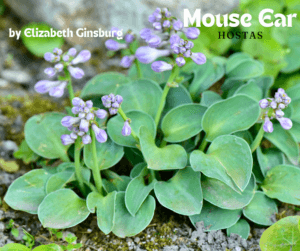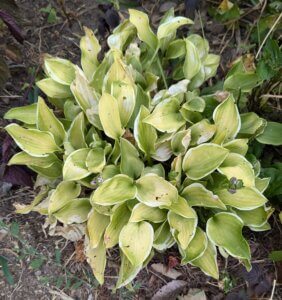
Hostas are the salvation of many a shade garden. With leaves ranging from pale green to darkest blue-green, and a host of shapes, sizes, variegated options and bloom times, they are relatively undemanding workhorses. Many are also prolific, with dividable clumps that make it easy and inexpensive for average gardeners to increase supplies over time.
No Space for Giants
But not everyone has space for a variety like the enormous ‘Empress Wu’, which grows nearly four feet tall and almost six feet wide. Even a more moderately-sized variety, like the old favorite, ‘Royal Standard’, at 26 inches tall and 18 inches wide, may be too big for small space and container arrays. Those situations call for small varieties—either miniatures, which grow up to six inches tall, or small cultivars that grow up to 10 inches in height. One of the best-known is ‘Blue Mouse Ears’, which grows only six to 12 inches tall, with a spread of eight to 12 inches.
Mice in the Garden
While some small hostas have the word “mouse” in their varietal names (usually indicating descent from ‘Blue Mouse Ears’), many more fit that variety’s miniscule dimensions. Gardeners sometimes refer to all the small cultivars as “mouse ear” hostas.
When attached to real mice, “mouse ears” are tiny. The typical leaf on a mouse ear hosta is a little larger, ranging from slightly bigger than a thumbnail to the size of a potato chip.
Plant breeders, ever conscious of market trends, including the trend for small-space landscapes, have gone to work and produced lots of small varieties that mimic the qualities of larger specimens, while adding a unique charm of their own.
Singing the Blues
Hostas with blue-green leaves add contrast to shady spots. An offspring of ‘Blue Mouse Ears’, little ‘Thumb Bluelina’ is only five inches tall with a spread of about 17 inches. ‘Thumb Bluelina’s’ leaves are medium blue-green, and about the size of a thumbnail. The plants would work especially well massed at the front of a shady border, or providing a splash of blue in a rock garden.
Golden Green
Finding light in small, dark spaces can be hard, but mouse ear hostas can romp to the rescue. ‘Sun Mouse’, which boasts ‘Blue Mouse Ears’ in its genetic heritage, features golden green leaves that are longer than they are wide, and ripple at the edges. The plant is a mighty mite at six inches tall and about 18 inches wide. Like many hostas, it bears lavender blooms in summer. ‘Golden Needles’ sports an unusual color pattern, with green-gold leaves flecked over the entire leaf surface with darker green. ‘Yellow Saphire’, grows even lower, rising only one inch, with a spread of eight inches and pointed, leaves that are more yellow than green. Its low stature makes it useful as a small-space groundcover.
Twice as Nice
Variegated leaves—where the green base color is edged, striped or splotched with a contrasting shade, can sparkle in the shade garden or container array. ‘School Mouse’, another ‘Blue Mouse Ears’ offspring, came to market by way of a series of complicated breeding maneuvers. Rising to eight inches tall, with a 12 inch spread, the plants shine with green foliage (sometimes with blue overtones), edged in yellow green. Even smaller, at only five inches tall, little ‘Mini Skirt’, also shines with slightly wavy yellow leaf margins. ‘Twice as Mice’ has the mounding habit of many larger hostas, but only tops out at five inches tall and 18 inches wide. Its blue-green leaves come complete with feathery cream edges.
Shapely Foliage
Hosta collectors treasure specimens with interesting leaf shapes and configurations. If you have an urge for the small and unusual, try ‘Golden Fantasma’, at only three inches tall and 12 inches wide. Its abundant golden leaves are narrow and pointed at the ends, like small swords. ‘Wizard of Ahhs’ features similar golden-green swords that are darker green on the undersides. ‘Crazy Mouse’ is a little larger at 8 inches tall and nearly two feet wide. Its rounded leaves are more blue than green and tightly clustered together, making the plant look almost flower-like.
Easy on the Gardener
Mouse ear hostas, like their larger relations, are among the easiest plants to grow. All thrive in shade, but some will tolerate fair amounts of sun. Start mouse ears off with well-drained soil, amended with a nutrient-rich mixture like Fafard Garden Manure Blend. Water regularly until the plant is well-established. If your small hostas are growing in containers, they will need relatively more water than specimens planted in-ground. If you live in a cold winter climate, store containerized hostas in protected locations.
Clumps of happy hostas—large or small—will grow in size, making division the best option for increasing supplies. It is easiest to divide hostas in spring, when the young shoots are just emerging. Dig up the entire rooted clump, and then use a sharp spade or garden knife to divide the clump into several pieces, making sure that each one has a section of roots attached. Replant the new divisions or donate them to lucky friends, who will almost certainly welcome your gift of healthy “mice”.

About Elisabeth Ginsburg
Born into a gardening family, Elisabeth Ginsburg grew her first plants as a young child. Her hands-on experiences range from container gardening on a Missouri balcony to mixed borders in the New Jersey suburbs and vacation gardening in Central New York State. She has studied horticulture at the New York Botanical Garden and elsewhere and has also written about gardens, landscape history and ecology for years in traditional and online publications including The New York Times Sunday “Cuttings” column, the Times Regional Weeklies, Horticulture, Garden Design, Flower & Garden, The Christian Science Monitor and many others. Her “Gardener’s Apprentice” weekly column appears in papers belonging to the Worrall chain of suburban northern and central New Jersey weekly newspapers and online at http://www.gardenersapprentice.com. She and her feline “garden supervisors” live in northern New Jersey.

